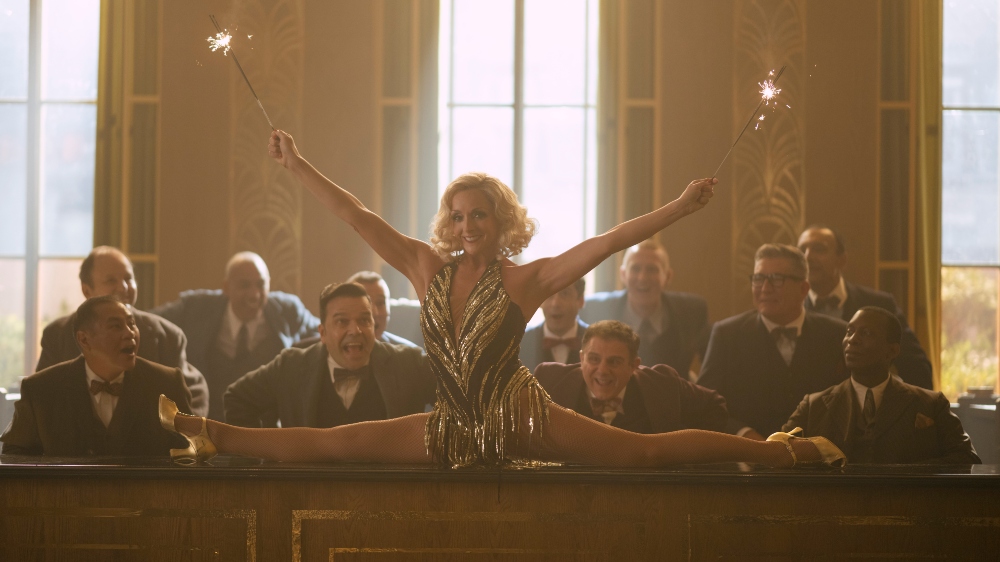
There’s more magic to do in Season 2 of Schmigadoon!, where newlyweds Melissa (Cecily Strong) and Josh (Keegan-Michael Key) — missing their musical happy lives — try to return to where it all began. While looking for the town of Schmigadoon, they turn a corner into the depraved world of “Schmicago,” where murderous and mysterious players perform reimagined numbers from ’60s and ’70s Broadway musicals such as Chicago, Cabaret, Annie, Oliver!, Sweeney Todd, Sweet Charity, Company, Pippin, Godspell, Hair, Jesus Christ Superstar, A Chorus Line, and more.
Where there is music, there is also dance, and that’s where Emmy-nominated choreographer Christopher Gattelli steps in. Known for creating the dances for such Broadway shows as Martin Short: Fame Becomes Me and High Fidelity The Ritz, Sunday in the Park with George (2008 revival), South Pacific, Women on the Verge of a Nervous Breakdown, Godspell, Newsies, and the 2015 revival of The King and I. Gattelli is a seasoned Broadway baby, having also danced as a performer in the Broadway and national tours of Cats, Evita, Guys and Dolls, and Fosse. Musical theater enthusiasts will get a real kick from Gattelli’s choreography, which was a natural to recreate the famous jazz hands and hip swivels of Bob Fosse, accenting moves with his own style.
Below the Line spoke with Christopher Gattelli via Zoom video from a rehearsal studio in New York where he was busy working on an upcoming Broadway musical, Take The Lead, which was also a film starring Antonio Banderas as renowned dancer Pierre Dulaine. Gattelli talks about recreating and putting his own stamp on some of the iconic movie dance moments of Bob Fosse’s career, from the opening song, “Welcome To Schmicago,” a send-up of “Magic To Do” from Pippin, performed by Titus Burgess, to Adriana Bowes singing “Do We Shock You?” a parody of “Hey Big Spender” from Sweet Charity. Not to mention the 11 o’clock number “Bells and Whistles,” performed by Jane Krakowski, referencing “Razzle Dazzle” from the musical Chicago, complete with trapeze work and rollerskating — a throwback from her time on Starlight Express. Gattelli reveals there are plenty of Easter eggs to find throughout the six episodes of Season 2, which pay tribute to acclaimed Broadway musicals.
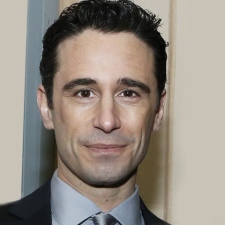
Below the Line: What a great way to open the second season, with Titus Burgess as a send-up of The Leading Player in Pippin singing a parody of “Magic To Do.”
Christopher Gattelli: It was in the script: “We get through the opening segment, and then out of the fog, 20 white-gloved, jazz hands appear.” [laughs] So right off the bat That was such a fun one. It’s such a great iconic moment of the ’70s. So to start there, it was such a brilliant stroke.
BTL: How much did you have to go back to watch the original musicals to sort of get a gauge of the choreography?
Gattelli: Dancing in Fosse and whatnot, I knew this period physically better in terms of choreography and spoofing it, like the Turkey Lurky [dance]. I’ve done all of those before, but I wanted to pay attention to the camera work. The reason Schmigadoon! [creator] Cinco [Paul] originally approached me was because he knew I could work with long takes and a full body in the frame. There were much fewer cuts in those Golden Age musicals, but then in the ’60s and ’70s, Fosse was amazing at how he used the camera and how he got his shots and the angles that he got his shots of body parts, or a martini glass in a waiter’s tray, or something in the foreground; it just had layers. So I was really digging into research about that because I knew the dance would be fun, but I also wanted to really try to pay homage to the camera work as well. You know there’s a specific shot of Liza [Minnelli] in Cabaret, walking from the back, just the way he tracked her feet as she walked forward on stage, and we do that in the bus in “Talk to Daddy” with Dove [Cameron]. There were even specific shots that I was very inspired by and wanted to, if not replicate, at least pay homage to and take things from different angles. That was a really fun part to dig into what shots could be really cool, as well as the choreography.
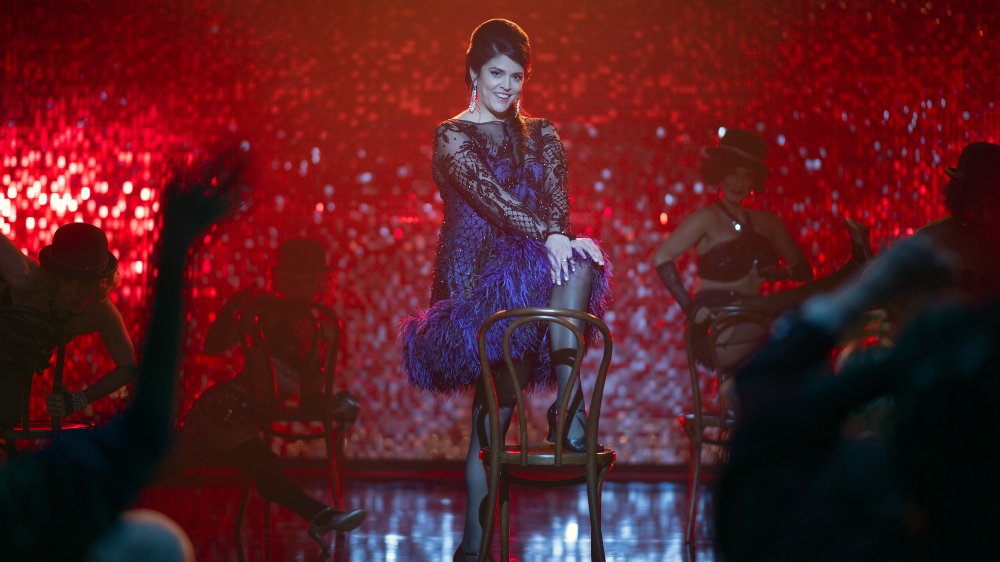
BTL: Were you involved with choosing the musical numbers and the shows that were going to be a part of Season 2?
Gattelli: [Creator] Cinco Paul and the writer’s room developed the season, and they sent the six episodes and scripts, and the numbers were pretty much there in terms of the songs themselves. For example, “Welcome to Schmicago” is definitely a reference to “Magic to Do,” and so was “Kaput Mein Heir.” We do “We Shock You” instead of “Big Spender.” They were very specific in terms of the women at the bar. But in terms of the overall shape and sculpting of the numbers, that was me, but slash, all of us were kind of working together and pitching ideas back and forth. Like, “Oh, what if it’s a mashup of this number? Knowing that we’re grounded and based on a number, but then opening it up and pulling in different quotes from other musicals, I think, is what made it so much fun. That’s why I love the show so much because it’s not just a parody or homage to that specific number. It’s its own world, so we get to really take in all the threads. They’re so rich with detail and little Easter eggs for musical theater fans. It’s a dream job, basically.
BTL: Can you reference other Easter eggs in the show?
Gattelli: I did direct an off-Broadway musical called Silence the Musical. Talk about a parody. It was a parody of Silence of the Lambs. I referenced my own show in Episode 3. There’s the “Parable of the Lamb,” so we put socks on their arms and black spray paint caps on their hands. That was a complete homage to my own show. It’s such a Level 17 Easter egg, but it works for the show.
BTL: Absolutely. And it’s funny you say parody versus homage. I find the songs were parody, but the dances were more of an homage.
Gattelli: Thank you. I really appreciate that, because I feel like it’s set up as a parody and it’s obviously funny, but in terms of my job with the numbers, it’s still kind of keeping the story going and making sure, like in musical theater, the numbers still keep driving the plot forward or learning more about the characters. It is more of an homage in terms of what a classic musical theater number does, which is continue to tell a story, but I am paying homage to all of my heroes. They’re all there, whether it was the first season or the season between Bob Fosse, Michael Bennett, and Jerome Robbins. I get to show maybe new generations steps and styles that maybe they didn’t grow up with and think are interesting. In a way, I feel like I’m getting to pass the torch a little bit and expose audiences to shades of their work.
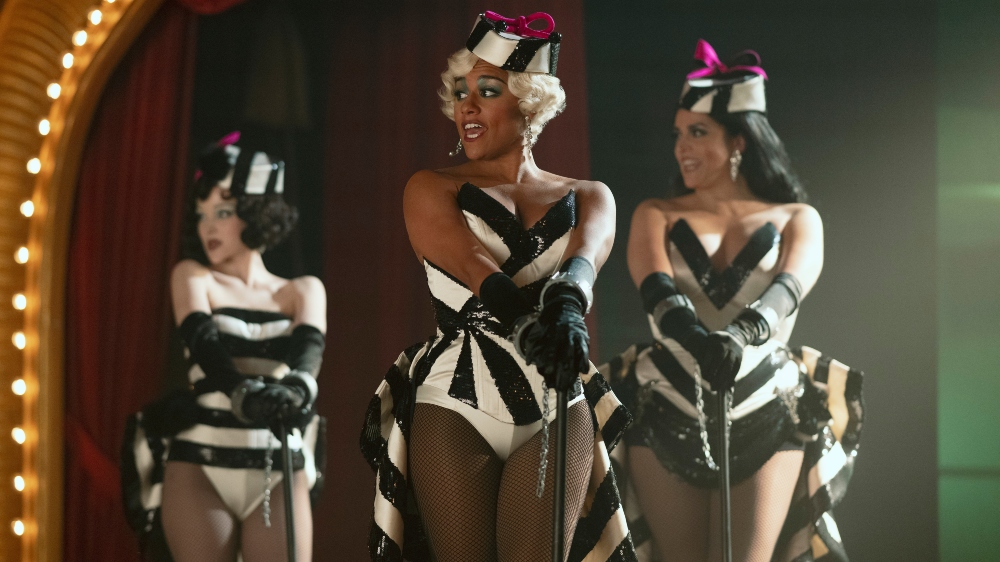
BTL: You actually danced in Fosse so that must have been a thrill for you when you know his choreography like the back of your hand, pun intended.
Gattelli: [laughs] Like the back of my jazz hands. Yeah, Fosse was actually the last Broadway show I performed in. So when we got to the season and especially the “Talk To Daddy” sequence, doing the Frug [dance] every night was one of the best moments. I literally get to do the Frug on Broadway; that alone is a dream come true, but then to get to reference it, honor it, and then twist it in fun ways, again, presenting it to an audience in a different way, It just felt good to create something that works so well.
BTL: Have you heard from Bob Fosse’s daughter Nicole about what you’ve done with her father’s work?
Gattelli: I know Nicole. I haven’t heard from her yet. A lot of my dancer friends from Fosse, colleagues, and peers have written to me. I think they feel the same way about how great it is to be able to have this on screen in this context. To make it accessible to people who might not go to the theater. It’s so great to be able to have that out there. The support has been really lovely.
BTL: Tell me about auditioning your dancers. What was the process for that?
Gattelli: It was really interesting because we shot both seasons during the pandemic slash COVID, so I was never able to do in-the-room auditions, especially with the traveling in the first season. I had to get a special permit and everything just to be able to work in Canada because we shot it in Vancouver, so I couldn’t even go early to audition a room of dancers because, one, I couldn’t travel, and two, you couldn’t even get in the studio. So they were all taped submissions. I had to put the dance combination on the video, and then they would send the video out. For the first season, we actually did a Zoom audition, which is really tricky because timing is off, but this time we did a combination that they learned and then submitted back via video, and it was great. Plus, we had a lot of returnees this year, which was fun, but a lot of new talent too. So it was a great mix and lift to kind of give us some new blood and some new energy, but also have the kind of support from Season 1. There was a moment in “Welcome to Schmicago” that the first two dancers that appeared were specifically a couple from Season 1, and I did that specifically because I knew that we were going to get into Josh (Keegan-Michael Key) and Melissa (Cecily Strong) confusing the mayor, Alan’s [Cumming] character now, and so it would probably be fun to put those kinds of central (for the audience) to think, “Wait, those are the dancers too,” even down to that level of is this a new place? Are they the same people? It was fun to consider that in the staging of it.
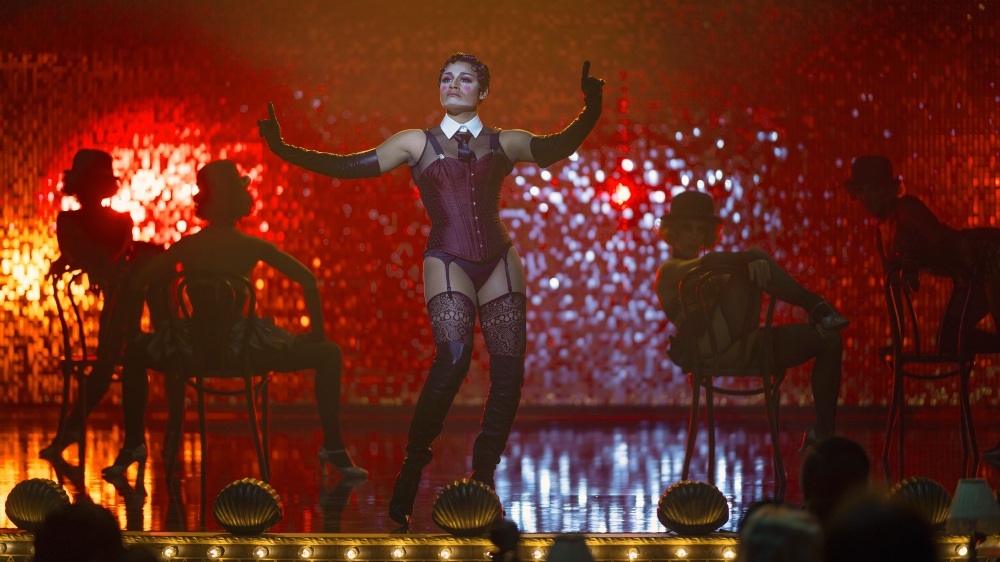
BTL: What’s it like working with non-dancers and trying to teach them choreography like Keegan and Cecily?
Gattelli: You know, Cecily, she’s a great singer, but it’s like I always say with any non-dancer, I always feel like everyone can dance. I think there’s a level of security. As long as they’re willing, and the thing is, everyone, especially Cecily and Keegan, did more dancing in the first season, but they’re just very willing and they want to be great. They work really hard, plus we’re just laughing in rehearsals all the time because they’re both so hilarious that you kind of get work done. I’m kidding you. They’re total pros, and I love every second in the room with them.
BTL: One of my favorite numbers was “Bells And Whistles” with Jane Krakowski who is a seasoned Broadway performer. How much fun was it to work with her?
Gattelli: I knew she had that special skill [laughs] of rollerskating from Starlight Express, so I was like, Jane, you’re getting on skates! She was like, sure, whatever. I mean from day one, she was like, this is what I can do. What else do I need to learn? Let’s go for it. It was in the script that “Bobby enters on a trapeze into the courtroom” and then in my head, it’s like a slight dip in [Broadway musical] Nine. When I met her for the first time in person and we started talking through ideas she was like, “Well, I’m gonna swing on it, right?” And I was like, “Do you want to?!” She’s like, ‘Chris, if they’re bringing in a trapeze, I’m gonna have to use it too!’ [laughs] She actually found there’s a trapeze school right around the block from the studios and went there on her break. Oddly enough, I’ve been on a trapeze before and it’s very difficult on the back of your knees because all the gravity is pulling down so I wanted her to be safe and feel good doing it too. It was all done safely and things that were manageable. There [are] no doubles. That’s all Jane. She does the back walk-over off of the trapeze onto the floor in heels. When we all saw that in the script, it was like, that number is like a gift. A lot of care went into everything, but a lot of attention was paid to like really crafting it well, specifically for her, who’s such a triple, quadruple threat that it was really fun.
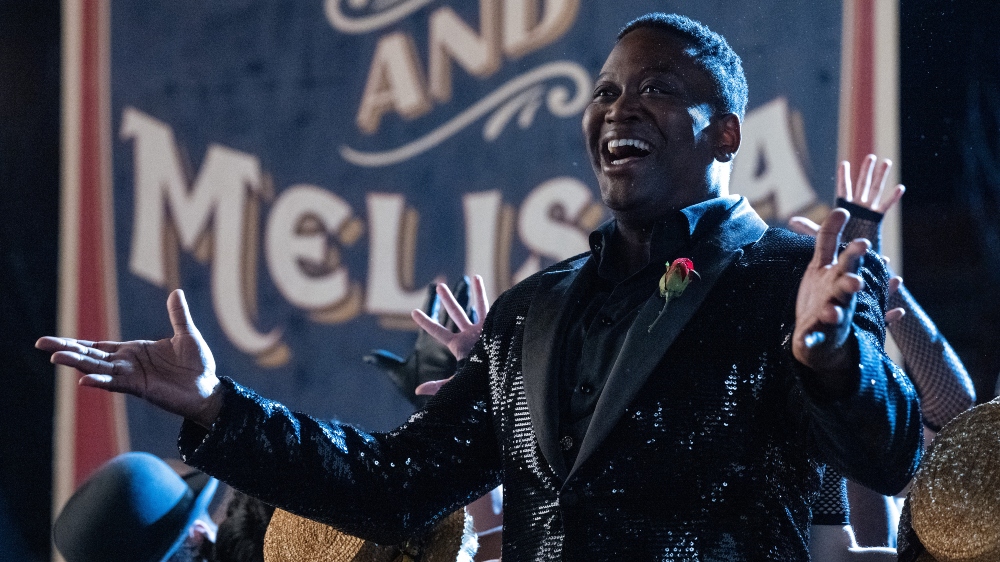
BTL: What inspires me so much about dancers is how they are also triple threats — singing, dancing, and acting.
Gattelli: It’s stamina, and I think that’s what I love about the show too. Sometimes in film and TV, it’s dubbed or they’re singing to a track, but for the most part, they’re capturing the vocals live while they’re shooting this. I mean, edits, of course, are a little different, but for the most part, they’re singing and dancing live. It’s kind of a different breed; these are people who can literally do it all in real-time in front of you. I feel that that’s something that comes across on TV beyond the screen. You’re aware that they’re doing this for real, even though it is filmed, but you can tell that they are actually doing it, and there’s something to that. That’s just one of those special things that’s innate. It’s special to watch someone do it live, you know?
BTL: How much do your dancers inform your choreography and your creativity?
Gattelli: They do, for sure. I’ll build a structure for the number, and I’ll think of how to craft it. But then I always leave room open. I don’t pen myself into any specifics; this is what it has to be. I’m very collaborative with all the artists, whether it’s the core ensemble dancers or anyone else. It just kind of makes the soup a little richer and definitely plays into a lot of how I stage something, especially if I know the group going in or have seen them. It’s definitely being crafted with them in mind.
BTL: I know it’s difficult to choose but which number was your favorite?
Gattelli: I know it’s so hard. It’s a toss-up between “Bells and Whistles,” “Talk To Daddy,” and “Good Enough To Eat,” all for different reasons. My favorite is “Talk To Daddy,” mainly because it was a collective, a lot of people working together, and a very ambitious shoot. When I sent my pre-vis ahead to the team, they were kind of like, “Wow, this looks really interesting.” If we can get these overheads and the shot on the bus, they’re like, “Let’s do it. Every single department and the dancers were all working so hard to make it happen and get it shot in like a day. I was so happy that they did, because I feel like it’s the most kind of homage in terms of that period and style of just camera work. That, to me, is my homage to Fosse and what he contributed to film and TV. There are special memories about all of them.
Season 2 of Schmigadoon! is now streaming on Apple TV+.





